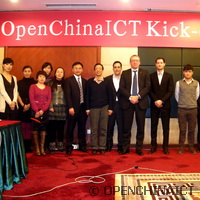Towards EU-China cooperation in ICT
FP7 projects are not all about concrete research and new technologies. Some initiatives - equally important - aim to forge bonds between scientific communities, whether from different disciplines or different regions. The OPENCHINAICT project is one example. 'Information and communication technologies' (ICTs) are one of the most competitive and innovative markets in the world. The statistics speak for themselves: over 2.7 billion people are using the internet in 2013, and more than 6 billion have access to a mobile phone. According to European Commission Vice-President Neelie Kroes, fully completing the EU's single market in digital communications could boost our economy by up to EUR 110 billion a year; over 0.8 % of the EU's GDP. Innovation, better infrastructures and investment in R&D are key to achieving this objective, as the sector does not allow for 'second thoughts'. International competition is fierce, with countries such as China expected to spend as much as EUR 234 billion on ICTs in 2013. But is there room for cooperation as well? The FP7-funded project OPENCHINAICT1 has spent almost two years emphasising the mutual benefits increased cooperation could bring to the two regions. Europe has much to learn from China's efforts in ICT research to prepare for future challenges, and Chinese ICT research can benefit from integration into the European research environment. Kay Matzner, coordinator of OPENCHINAICT, told research*eu results magazine about the actions taken by the project to enhance direct dialogue among stakeholders - including policy-makers and researchers - from both the EU and China. What are the main objectives of the project? The overall objective of OPENCHINAICT was to significantly and measurably contribute to the facilitation of ICT-related research cooperation between Europe and China. This has been implemented by the creation of both a European and a Chinese roadmap survey to review ICT research landscapes on both sides. To enhance further cooperation and initiate policy dialogues, the project organised a major conference and two thematic workshops related respectively to 'Smart and sustainable cities' and to the 'Internet of Things', in different Chinese regions. Furthermore, policy consultation meetings between official stakeholders from Europe and China have been supported by the consortium. The project outputs have been used to draft the 'EU-China ICT cooperation plan', which is intended as a guideline for the European Commission's DG CONNECT to promote international Europe-China cooperation in ICT. Can international competition coexist with increased cooperation? All economic and econometric theories and data support internationalisation in view of the benefits for all in terms of economic integration and research. In research, such collaborations are crucial for making breakthroughs and tackling global challenges, as they give access to the best competences and minds available. Internationalisation has fully impacted R&D systems everywhere in the world, and innovation value chains are now interconnected. The overall economic impact of internationalisation for all actors involved is positive due to capacity effects, reverse technology transfers, market access effects and other advantages. In the case of China, an important driver for successful European economies has been increased trade in high-technology products. It helped us cope with the recent global financial crisis, but this entails Europe being able to assess its own innovation systems. Some less successful European economies still have room for improvement in this regard. What mutual benefits do you expect from ICT collaboration with China? The OPENCHINAICT consortia carried out a thorough analysis in China and Europe to review and better understand all important aspects of such collaboration. Chinese and European contributors identified potential mutual benefits such as market-access opportunities, mutual implementation of standards, mutual know-how access and exchange, improved political dialogues, and mutual access to human and in-kind resources. However, such collaborations are challenged on both sides by cultural misunderstandings, unintended know-how transfers, competition and political conflicts. Whilst Europeans seem rather supportive of such collaborations, our Chinese interlocutors don't fully understand the added value of European Commission-funded research for them and are therefore reluctant to support such collaborations on a European level with their own resources. What difficulties did you encounter and how did you solve them? Projects with partners from emerging economies such as China are always challenging. This is notably due to differences in terms of working cultures, organisational structures, methodologies, backgrounds and legal environments. Such challenges may lead to delays in project implementation, and cannot always be anticipated when setting up such projects, as people and partners are always different. OPENCHINAICT was no exception in this regard, but we managed to solve these issues by intensifying our communication and management efforts. What are the concrete results from the project so far? OPENCHINAICT is not conducting concrete research but rather working on the facilitation of a dialogue between European and Chinese stakeholders to facilitate and develop real research cooperation. The main tangible result is the cooperation plan we put together, but we also enhanced networking channels for Chinese and European officials and researchers. How will the project benefit ICT research and cooperation? The project consortium presumes that the cooperation plan will be widely received and accepted by the European Commission and Chinese officials. It will provide them with guidance on how to improve research collaborations. What are the next steps in the project? The project is progressing with its two most important goals: publication of the final cooperation plan and the final OPENCHINAICT conference which will be held in Vilnius on 5 November. Participants interested in our conference or in accessing our project documents should check our project webpage. The project is coordinated by Fraunhofer in Germany.For more information, please visit: OPENCHINAICT http://openchina-ict.eu/ Project factsheet
Countries
Germany



